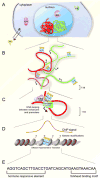Genome-wide mechanisms of nuclear receptor action
- PMID: 19800253
- PMCID: PMC2818176
- DOI: 10.1016/j.tem.2009.08.006
Genome-wide mechanisms of nuclear receptor action
Abstract
Nuclear receptors are involved in a myriad of physiological processes, responding to ligands and binding to DNA at sequence-specific cis-regulatory elements. This binding occurs in the context of chromatin, a critical factor in regulating eukaryotic transcription. Recent high-throughput assays have examined nuclear receptor action genome-wide, advancing our understanding of receptor binding to regulatory elements. Here, we discuss current knowledge of genome-wide response element occupancy by receptors and the function of transcription factor networks in regulating nuclear receptor action. We highlight emerging roles for the epigenome, chromatin remodeling, histone modification, histone variants and long-range chromosomal interactions in nuclear receptor binding and receptor-dependent gene regulation. These mechanisms contribute importantly to the action of nuclear receptors in health and disease.
Figures

References
-
- Fryer CJ, Archer TK. Chromatin remodeling by the glucocorticoid receptor requires the BRG1 complex. Nature. 1998;393:88–91. - PubMed
-
- Gargiulo G, et al. NA-Seq: a discovery tool for the analysis of chromatin structure and dynamics during differentiation. Dev Cell. 2009;16:466–481. - PubMed
-
- Ishihara K, et al. CTCF-dependent chromatin insulator is linked to epigenetic remodeling. Mol Cell. 2006;23:733–742. - PubMed
Publication types
MeSH terms
Substances
Grants and funding
LinkOut - more resources
Full Text Sources
Molecular Biology Databases

